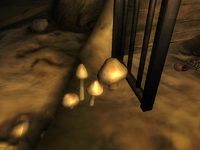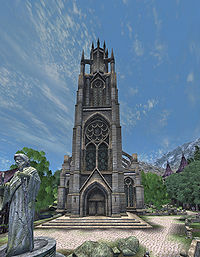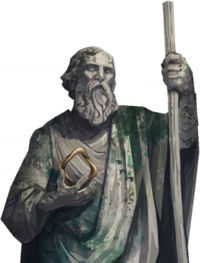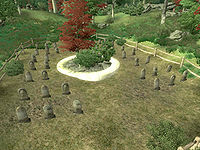Lore:Death/Imperial
Imperial Beliefs and Customs[edit]
Cultural Beliefs and Traditions[edit]
The Old Life Festival is an Imperial tradition observed all over Tamriel. At the end of the year, people light candles around a shrine and write messages to their deceased loved ones in the hope that it reaches them in Aetherius. This tradition complements the more well-known New Life Festival. One must acknowledge the old year to pass on to the new year.[1] It is believed that the cave mushroom, the Cairn Bolete mark the place someone has died.[2]
In Nibenay, many villagers place their dead in paper hako-skiffs and float them down the rivers. These boats have a dragon-motif, harkening back to the Akaviri of the Second Empire.[3] Memorial Cave in the southeast Heartlands, on Lake Rumare is a burial ground for heroes of the many past wars and conflicts.[4]
Imperial Afterlife[edit]
Imperials worship Arkay, one of their Divines, as the paramount god of the dead. His worship, at least as recorded in written history, originated after that of Nord Orkey and elven Xarxes and it is taught that he was a mortal who ascended to godhood. Scholar views on the matter explains that Arkay is merely a convenient syncretic god between Orkey and Xarxes, becoming an integral part of the religion of the Nedes (and the people descending from them) freed by Alessia.[5] The Imperials became the most influenced society by the Alessian Order and its vision of the afterlife. Alessians believed that one devoted to their doctrines can persist beyond the illusion of death, this is, to expunge corruption and conquer the Arkayn Cycle.[6]
Imperials call Aetherius, the realm of the afterlife, Heaven.[7][8] Imperial Theosophy teaches that Heaven is also the plane of pure magicka and the seat of the Divines and the other original spirits. Oblivion surrounds Mundus every night, but from Aetherius, energy infuses the daily existence, from highest to lowest, and gives all common purpose. Its magic "brings the rain to the fields, love to the hearts, and scientific principles to the technological industries". It gives the very Sun itself. Finally, Aetherius is the home to the Aedra, those cornerstones of the Mundus whose aspects are seen "in temple, in lordship, and the high walk of heroes".[8]
Imperial Funerary Customs[edit]
Imperials bury all their dead, commonly underground both in graveyards, built in the interior of and vicinity of cities and towns; and also in catacombs below the chapels of the Churches of the Eight or the Nine, depending on the age. Gravestones dot the terrain of Imperial graveyards, signaling the location of the buried coffins where the dead rest. This is the most common form of entombment for commoners. On the other side, the nobility is commonly buried in crypts and catacombs, usually built outside of the cities and towns or below the temples of the Imperial cities. All these places are commonly guarded by Arkay's priests, who watch over the rest of the dead.[9]
Arkay's priests in Cyrodiil and beyond give every Imperial his Three Consecrations, to protect the souls and the bodies of the deceased, just like the Bretons do.[10]
Most, if not all, Imperial buried bodies are anointed with the Three Consecrations, even criminals who will be executed by the law.[11] Necromancy is still a common practice in Cyrodiil, due to the disposal of corpses given by the government to certain necromancers allied with the state to practice their arts.[12][13]
One particular place held by the Imperials as especially sacred as a burial ground is Sancre Tor, where the ancient tombs of the Reman emperors lie. Following the defeat of the Akaviri invaders, Sancre Tor enjoyed a brief resurgence of wealth and culture under Reman Cyrodiil and his descendants, Reman II and Reman III. Tracing his ancestry to Saint Alessia, and following the tradition that Saint Alessia was buried in the catacombs beneath Sancre Tor, although some may say she is buried under the Temple of the One, Reman built splendid funerary precincts in the depths of the ancient citadel under-passages. Here the last Reman emperor, Reman III, was buried in his tomb with the Amulet of Kings.[14] During the Interregnum, the place became abandoned, and not one of the numerous Emperors were buried in Sancre Tor.[15] The place was only briefly reoccupied before Tiber Septim lay siege to the holy city and recovered the Amulet of Kings. After that, neither the Septim nor the Mede Emperors bury their remains in Sancre Tor.[14]
References[edit]
- ^ Petronius Galenus' dialogue in ESO
- ^ Wilderness rumors in Oblivion
- ^ Pocket Guide to the Empire, 1st Edition: Cyrodiil — Imperial Geographical Society, 2E 864
- ^ Phintias' dialogue in Oblivion
- ^ Tu'whacca, Arkay, Xarxes — Lady Cinnabar of Taneth
- ^ The Illusion of Death
- ^ Artorius Ponticus Answers Your Questions — Bishop Artorius Ponticus
- ^ a b Pocket Guide to the Empire, 3rd Edition: Arena Supermundus: The Tapestry of Heaven — Imperial Geographical Society, 3E 432
- ^ Frederique Lynielle's dialogue during Unearthing the Past in ESO
- ^ The Consecrations of Arkay — Punctilius Tyrus
- ^ Priestess of Arkay's dialogue in Skyrim
- ^ Corpse Preparation
- ^ Arkay the Enemy — KW
- ^ a b The Legendary Sancre Tor — Matera Chapel
- ^ Events of ESO
|
||||||||||||||







